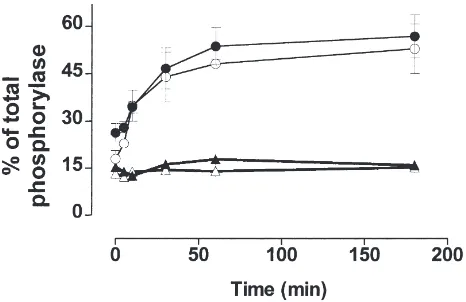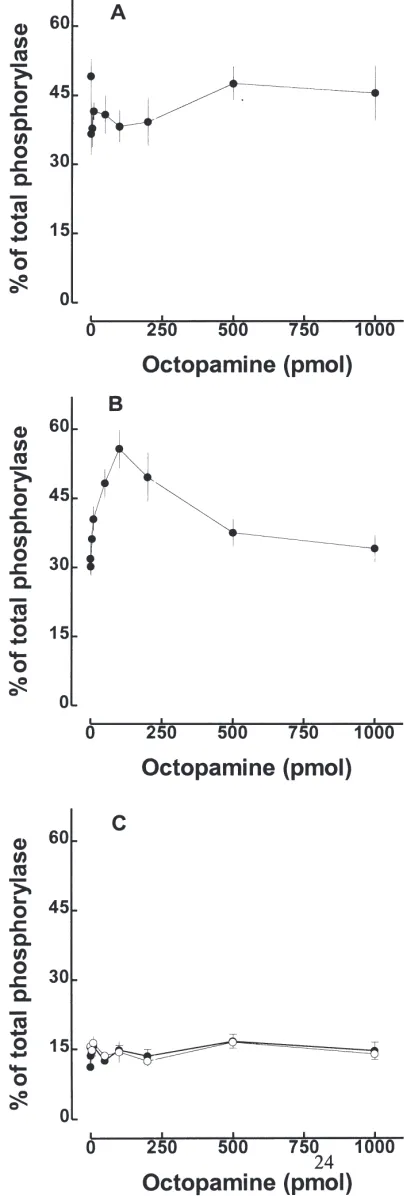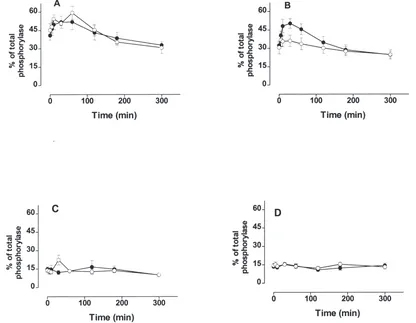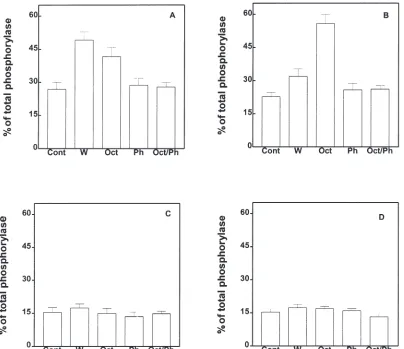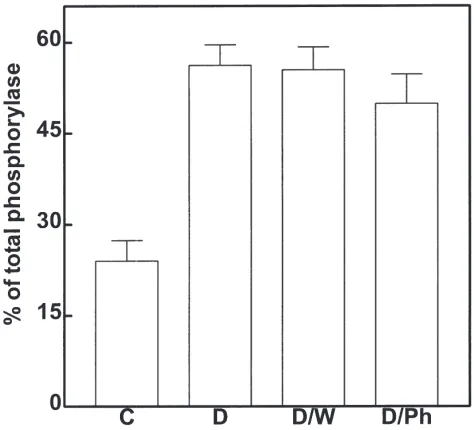www.elsevier.com/locate/ibmb
Developmental changes in the response of larval Manduca sexta
fat body glycogen phosphorylase to starvation, stress and
octopamine
Jose´ Roberto Meyer-Fernandes
1,2, Katia C. Gondim
1,3, Michael A. Wells
*Department of Biochemistry and Center of Insect Science, Biological Sciences West, University of Arizona, Tucson, AZ 85721, USA
Received 17 May 1999; received in revised form 5 January 2000; accepted 10 January 2000
Abstract
Fasting or starvation of 1st- and 2nd-day fifth instar Manduca sexta larvae leads to rapid activation of fat body glycogen
phosphoryl-ase. Under feeding conditions, 21–29% of the phosphorylase was found in the active form. However, after only one hour of starvation, the active form increased to 55–65%. In larvae on the 3rd-day there was a slower increase in the activation, requiring
three hours of starvation to reach a maximum of 60–65%. No activation was observed in 4th-day larvae after three hours of starvation.
When 1st- or 2nd-day larvae were decapitated, the time-course of activation of glycogen phosphorylase was very similar to that
observed in intact insects. However, activation of glycogen phosphorylase following decapitation was only observed in 1st- and
2nd-day larvae. In 2nd-day larvae, octopamine promoted activation of glycogen phosphorylase and 100-pmol of octopamine promoted
maximum activation. Higher amounts of injected octopamine caused a decrease in activation. The injection of 100 pmol of octopam-ine caused a 50–55% activation of phosphorylase within 30 minutes. The simultaneous injection of the α-adrenergic receptor antagonist phentolamine with octopamine blocked the octopamine effect in 1st- and 2nd-day feeding larvae. However, the activation
of glycogen phosphorylase observed in ligated/decapitated larvae on the 1st- and 2nd-day was not abolished by injection of
phentolam-ine. All of these data suggest that factors other than adipokinetic hormone and octopamine may be involved in the activation of glycogen phosphorylase during fasting or starvation in the early part of the fifth larval stage of M. sexta. 2000 Elsevier Science Ltd. All rights reserved.
Keywords: Fat body; Manduca sexta; Glycogen phosphorylase; Octopamine; Stress; Adipokinetic hormone
1. Introduction
In insects two different types of hormones have been implicated in the mobilization of fat body energy stores: the adipokinetic hormones (AKHs), which are a family of structurally related peptides containing 8–10 amino acids that occur widely in insects (Orchard, 1987, Ga¨de, 1990), and octopamine, the major biogenic amine found
* Corresponding author. Tel.:+1-520-621-3847; fax: +1-520-621-9288.
E-mail address: [email protected] (M.A. Wells). 1 Permanent address: Departamento de Bioquı´mica Me´dica,
Insti-tuto de Cieˆncias Biome´dicas, Centro de Cieˆncias da Sau´de, Universid-ade Federal do Rio Janeiro UFRJ, Rio de Janeiro, RJ Brasil.
2 Recipient of a postdoctoral fellowship from Conselho Nacional
de Desenvolvimento Cientı´fico e Tecnolo´gico, (CNPq) Brasil.
3 Recipient of a fellowship from Pew Charitable Trusts (Latin
American Fellows Program).
0965-1748/00/$ - see front matter2000 Elsevier Science Ltd. All rights reserved. PII: S 0 9 6 5 - 1 7 4 8 ( 0 0 ) 0 0 0 1 5 - 1
in invertebrates (Axelrod and Saavedra, 1977), which acts both as a neurotransmitter, modulating the release of AKH from the corpus cardiacum (Passier et al., 1995), and as a hormone with direct energy store mobilizing activity on the fat body (Orchard and Loughton, 1985). Evidence that glycogenolysis in the insect fat body is under hormonal regulation has been reported in many insect species (for a review see Ga¨de, 1990). Injections of Manduca-AKH (M-AKH) into larvae of Manduca
sexta activates fat body glycogen phosphorylase (Ziegler, 1990; Ziegler et al., 1991; Siegert 1992, 1995; Siegert and Mordue, 1994), suggesting, but not proving, that M-AKH might play an important role in survival during larval fasting or starvation (Ziegler, 1995). In M.
sexta the activation of fat body glycogen phosphorylase
1987b). Thus, Ziegler (1984) and Siegert and Mordue (1994) showed that the response to injections of extracts from corpora cardiaca or AKH depends on the age of the animal during late larval development. Here we show that activation of glycogen phosphorylase during star-vation in the first 48 h of the last larval stage of M. sexta does not depend on AKH or octopamine.
2. Material and methods
2.1. Chemicals
d,l-octopamine, AMP, glycogen,
phosphoglucomut-ase, glucose-6-phosphoglucomutase,
glucose-6-phos-phate dehydrogenase and coenzymes were obtained from
Sigma Chemical Co. (St Louis, MO). [14]-C-inulin was
obtained from Amersham Life Science Inc. (Arlington Heights, IL).
Fig. 1. Time-course of activation of the glycogen phosphorylase in starved fifth instar larvae: (A) 1stday, (B) 2ndday, (C) 3rdday and (D) 4th
day. The response to starvation was measured as the percentage of the total phosphorylase activity present as phosphorylase a. Values given are means±S.E.M. of three independent experiments using three different insects each.
2.2. Insects
M. sexta were raised as previously described (Prasad
et al., 1986). Animals were synchronized at the end of the fourth larval instar by the appearance of head capsule apolysis (Truman et al., 1973). For most of the experi-ments, intact and fed animals were used, but in some experiments larvae were ligated with dental floss between the second and third pair of prolegs. Ligations were done at this position so that the anterior and pos-terior sections would have approximately equal amounts of fat body. Ligated larval abdomens were used to remove the influence of the brain, corpora cardiaca, corpora allata and prothoracic glands (Siegert, 1992). During starvation studies fecal pellets were removed to prevent coprophagy.
2.3. Determination of the fat body glycogen phosphorylase activity
and removed. The fat body cells were disrupted by homogenization in a buffer containing 50 mM MOPS– TRIS, pH 7.2, 5 mM NaF, 5 mM EDTA, 1 mM EGTA, and 1 mM dithiothreitol (DTT). The homogenate was centrifuged (20 min, 12,000 g) and the supernatant used for determination of glycogen phosphorylase activity in the direction of glycogen breakdown by coupling the production of glucose-1-phosphate to the reduction of NADP using phosphoglucomutase and glucose-6-phos-phate dehydrogenase. Standard conditions (Arrese et al., 1995) for measurement of glycogen phosphorylase activity were: 40 mM phosphate buffer (pH 7.0), 5 mM imidazole, 2 mM NaEDTA, 1.4 mM dithiothreitol
(DTT), 5 mM magnesium acetate, 4 µM glucose-1,
6-bisphosphate, 0.6 mM NADP, 2 mg/ml glycogen (free from AMP), 4 U of phosphoglucomutase, and 0.8 U of glucose-6-phosphate dehydrogenase. Thirty microliter aliquots of the supernatant fraction obtained from the fat body homogenate were assayed for active phosphorylase in the absence of 59-AMP (phosphorylase a activity), and for total phosphorylase activity in the presence of 2 mM 59-AMP (Arrese et al., 1995). Values for the active phos-phorylase a activity are expressed as the percentage of
total phosphorylase activity. Endogenous
NADP-dehydrogenase activity (e.g., glucose-6-phosphate
dehydrogenase) that is present in the homogenate super-natant resulted in NADP reduction that must be cor-rected for by a blank made without adding enzymes. If this correction is not made, the activation of phosphoryl-ase in the supernatant is overestimated (Arrese et al., 1995). All experiments were done three times using fat body from three different insects in each experiment.
2.4. Hemolymph volume determination
[14-C]-inulin (Amersham Life Science Inc., Arlington
Heights, IL, 1.74 µCi/mg) dissolved in PBS (10 mM
potassium phosphate, 0.15 M NaCl, pH 6.5) was used to determine the volume of the hemolymph. The insects
were weighed and 5–7 µl of a freshly prepared [14
C]-inulin solution (90,000–300,000 dpm) was injected into
the fourth pair of prolegs of each animal using a 10 µl
Hamilton syringe. Ninety minutes later, hemolymph was collected into a tube containing a few crystals of phenyl-thiourea from a puncture in the first pair of prolegs. An
aliquot (50µl) was taken, and added to 10 ml of liquid
scintillation cocktail (Budget-Solve, RPI, Mount Pros-pect, IL) to determine the radioactivity. The volume of hemolymph was determined according to the dilution of the injected 14C-inulin. For insects starved for 3 h,14
C-inulin was injected 90 min after the onset of starvation, and 90 min later hemolymph was collected. The insects were weighed before and at the end of the 3 h-star-vation treatment.
2.5. Statistics
Differences were evaluated for statistical significance using Student’s t-test.
3. Results and discussion
3.1. Effects of starvation in Manduca sexta larvae
It has been suggested that the activation of fat body glycogen phosphorylase may undergo developmental changes in M. sexta (Ziegler, 1984; Siegert and Mordue, 1994). However, the activation of glycogen
phosphoryl-ase during starvation had only been studied in 3rd-day
fifth instar larvae (Siegert, 1987b; Gies et al., 1988). In 1st- and 2nd-day fifth instar larvae the activation of
glyco-gen phosphorylase during starvation is very rapid (Fig. 1, panels A and B), increasing from 21–29% active phosphorylase in the feeding stage to 55–65% active phosphorylase after 1 h of starvation. In larvae on the
3rd-day, there was a slower increase in activation of
phosphorylase, requiring 3 h of starvation to reach a maximum of 60–65% (Fig. 1, panel C)—this value was maintained until 6 h. After this period a decrease in acti-vation of phosphorylase was observed (data not shown). No activation of phosphorylase was observed after 3 h of starvation in larvae of the 4th-day (Fig. 1, panel D).
M. sexta larvae feed nearly constantly day and night,
pausing only to molt (Reinecke et al., 1980). However, larvae from different days do stop eating for short per-iods of time. First and second-day larvae can be observed to stop feeding for 15–45 min, which is enough time to cause activation of glycogen phosphorylase (Fig. 1, panels A and B). Therefore, in these experiments, only larvae that had been actively feeding for at least 5 min
Fig. 2. Time-course of activation of the glycogen phosphorylase in decapitated fifth instar larvae: 1stday, (I) 2ndday, (s) 3rdday and (G)
4thday (g). The response to decapitation was measured as the
were selected for starvation studies, because it has been shown that after starvation, refeeding for 2–5 min is long enough to inactivate fat body glycogen phosphorylase (Siegert and Mordue, 1992).
3.2. Activation of glycogen phosphorylase in ligated/decapitated larvae
It has been proposed that AKH, at least in part, con-trols carbohydrate metabolism during starvation/fasting in larval M. sexta (Siegert and Ziegler, 1983; Ziegler et al., 1990; Siegert and Mordue, 1992; Ziegler, 1995).
Thus, when 4th-day fifth instar larvae (9–10 g body wt)
were injected with 20 pmol M-AKH they showed acti-vation of glycogen phosphorylase (Siegert and Mordue, 1994), even though larvae of this age showed no acti-vation of glycogen phosphorylase during a short time of starvation (Fig. 1, panel D). In the experiments shown in Fig. 2, feeding larvae from different days were ligated and decapitated, and the activation of the glycogen phorylase was studied. Activation of glycogen phos-phorylase was only observed in decapitated 1st-and 2nd
-day larvae, with a time-course of activation very similar to that observed during starvation of whole insects (Fig. 1, panels A and B). Thus, 1 h after ligation/decapitation, glycogen phosphorylase activation increased to a maximum. Interestingly, decapitation of larvae on the
3rd-and 4th-days did not cause activation of glycogen
phosphorylase after 3 h (Fig. 2). These data suggest that in larvae on the 1st-and 2nd-days, factors other than AKH
were responsible for the activation of glycogen phos-phorylase.
3.3. Effect of stress and octopamine on glycogen phosphorylase activation
The activation of glycogen phosphorylase observed in decapitated 1st
-and 2nd
-day larvae could result from
fac-Fig. 3. Effect of injection of water on activation of the glycogen phosphorylase in fed fifth instar larvae. Injection of 10µl of water (I), without injection (s). The response to injection of water was measured as the percentage of the total phosphorylase activity present as phos-phorylase a. Values given are means±S.E.M. of three independent experiments using three different insects each.
Fig. 4. Effect of increasing amounts of octopamine injected on acti-vation of the glycogen phosphorylase in fed fifth instar larvae: (A) 1st
day, (B) 2ndday, (C) 3rd(I) and 4th(s) days. The response to injection
tors related to stress (starvation) that are released from sources other than the head. In the cockroach (Matthews and Downer, 1974) and locust (Orchard et al., 1981) it was shown that the hyperglycemic and hyperlipemic responses are increased during stress conditions, and that octopamine is involved in both processes. In both insects (Davenport and Evans, 1984a) an increase in hemo-lymph octopamine levels is a general response to differ-ent forms of stress. Food deprivation also induces an increase in octopamine levels in the hemolymph of locusts (Davenport and Evans, 1984b) as well as in M.
sexta (Adamo et al., 1997). Ismail and Matsumura
(1992) showed that injections of octopamine elevated glucose and trehalose levels in the hemolymph of M.
sexta. It has been observed that hemolymph trehalose is
homeostatically regulated at the expense of tissue glyco-gen during starvation (Murphy and Wyatt, 1965; Steele and Hall, 1985). To test the possible effects of octopam-ine in the activation of glycogen phosphorylase in M.
sexta, it was necessary to inject the animals, but as
shown in Fig. 3, the injection of water into 1st- and 2nd
-day larvae activated glycogen phosphorylase, whereas in
3rd-and 4th-day larvae no activation was observed.
Fig. 5. Time-course of activation of the glycogen phosphorylase in fed fifth-instar larvae to injections of octopamine: 1stday, (A) 2ndday, (B)
3rdday and (C) 4thday larva (D). (I) 100 pmol octopamine and (s) water. The response to injection of octopamine was measured as the percentage
of the total phosphorylase activity present as phosphorylase a. Values given are means±S.E.M. of three independent experiments using three different insects each.
Because the hemolymph volume of a 4th-day larva is
four to five times higher than a 1stday larva, we injected
50 µl of water into 3rd-or 4th-day larvae, but found no
effect (data not shown). These results again point out the differences in response between early and late fifth instar larvae. In addition, no changes in the volume of hemo-lymph were observed during starvation, even after 24 h (data not shown) and the volumes determined were simi-lar to those previously reported (Beckage and Riddi-ford, 1982).
It was necessary to distinguish the response to injec-tions of water (Fig. 3) from that due to the injected octo-pamine. In this case, it was not possible to use ligated
larval abdomens because, as observed in Fig. 2, in 1st
-and 2nd-day larvae the removal of the head did not
elim-inate the rapid activation of glycogen phosphorylase, therefore we used feeding animals for these experiments. The dose response to octopamine is shown in Fig. 4. In larvae on the 1st-day (Fig. 4, panel A), it was not possible
Fig. 6. Effects of water, octopamine and phentolamine on the activation of glycogen phosphorylase in fed fifth instar larvae. 1stday, (A) 2ndday,
(B) 3rdday and (C) 4thday (D) larva were injected with either water (W); 100 pmol of octopamine (Oct); 100 pmol of phentolamine (Ph); or 100 pmol
each of octopamine and phentolamine. The response was measured as the percentage of the total phosphorylase activity present as phosphorylase a. Control (Cont) insects were not injected. Values given are means±S.E.M. of three independent experiments using three different insects each.
endogenous octopamine is released by the injection of water and it may be enough to promote the maximal activation of glycogen phosphorylase.
Second day larvae are less sensitive to injection of water (Fig. 3), and it was possible to observe the acti-vation of glycogen phosphorylase promoted by octopam-ine (Fig. 4, panel B, open circles). Interestingly, the dose response for octopamine showed two components (stimulatory and inhibitory). The injection of 100-pmol octopamine promoted maximal activation. In the second
day larvae (1.24±0.37 ml of hemolymph) this amount of
octopamine corresponded to 80.6±24.0 nM in the
hemo-lymph, which is in the same range of concentration of circulating octopamine (around 130 nM) reported for M.
sexta under starvation conditions (Adamo et al., 1997),
and for Schistocerca gregaria and Periplaneta
amer-icana (around 80–100 nM) under thermal stress
ditions (Davenport and Evans, 1984a). Above this con-centration a decrease in the activation of glycogen phosphorylase was observed (Fig. 4, panel B). This result might suggest that in M. sexta the octopamine
effect could be under feedback regulatory control. Fields and Woodring (1991) have suggested that high sugar levels might inhibit octopamine-dependent carbohydrate mobilization from the fat body in Acheta domesticus. Octopamine did not activate glycogen phosphorylase in 3rd
- and 4th
-day larvae (Fig. 4, panel C). These larvae also did not respond to starvation, injection of water, or decapitation.
3.4. The time-course of the effect of octopamine
Fig. 5 confirmed that only in 2nd-day larvae was it was
of octopamine. Although in 1st-day larvae it was not
possible to observe any difference between injections of water and octopamine (Fig. 5, panel A), the time-course for activation and inactivation was very similar to that observed in larvae on the 2nd-day after injections of
octo-pamine (Fig. 5, panel B). In the larvae on the 3rd and
4th days the injection of 100-pmol of octopamine failed
to activate glycogen phosphorylase (Fig. 5, panels C and D).
It has been shown in A. domesticus and M. sexta that the response to adipokinetic hormones in lipid mobiliz-ation and glycogen phosphorylase activmobiliz-ation depends on the age of insect (Woodring et al., 1990; Siegert and Mordue, 1994). Fields and Woodring (1991) showed that octopamine-induced mobilization of lipids and carbo-hydrates in adult of A. domesticus also depends on the age of the insect. Our results show that any effect by octopamine on activation of glycogen phosphorylase during the last larval stage M. sexta also depends on the age of the insect. The level of glucose in the hemolymph of 1st- and 2nd-day larvae (3.56±0.45 mM and 3.39±0.
29 mM, respectively) under feeding conditions is higher
than in 3rd- and 4th-day larvae (1.46±0.23 mM and
1.24±0.18 mM, respectively). Whether the glucose level
in the hemolymph is an important factor related to the activation of glycogen phosphorylase remains to be elucidated.
3.5. Effect of phentolamine on the activation of glycogen phosphorylase
The α-adrenergic receptor antagonist phentolamine
suppressed the activation of glycogen phosphorylase on
the 1st-and 2nd-days caused by water or octopamine
injection (Fig. 6, panels A and B). The suppression by phentolamine of the activation of the phosphorylase caused by injection of water (Fig. 6, panel A), suggests that a possible release of octopamine after injection of water could be involved on the activation of the phos-phorylase. The injection of phentolamine into 3rd- or 4th
-days larvae had no effect (Fig. 6, panels C and D). Lar-val M. sexta octopamine receptors therefore show characteristics similar to octopamine receptors in other insects (Fields and Woodring, 1991). The role of octopa-mine in energy mobilization has been related to adult stage flight activity (Orchard, 1987). Here we showed that octopamine was able to increase the active form of glycogen phosphorylase in the fat body of M. sexta lar-vae.
The activation of glycogen phosphorylase observed in ligated/decapitated 1st- and 2nd-day larvae (Fig. 2) was
not abolished by phentolamine (Fig. 7), suggesting that factors other than AKH and octopamine may be involved in the activation of the glycogen phosphorylase during starvation. Further studies will be required to charac-terize these factors.
Fig. 7. Effects of water and phentolamine on activation of glycogen phosphorylase in decapitated 2ndday fifth instar larvae. Insects were
ligated and decapitated and the activation of glycogen phosphorylase measured 30 min later (D); or insects were ligated and decapitated and injected with either water (D/W) or 100 pmol phentolamine (D/Ph) and the activation of glycogen phosphorylase measured 30 min later. Control insects (C) were not decapitated or injected. The response was measured as the percentage of the total phosphorylase activity present as phosphorylase a. Values given are means±S.E.M. of three inde-pendent experiments using three different insects each.
Acknowledgements
Mary Hernandez, our insect caretaker, provided valu-able advice and assistance throughout this study and without her help this study would not have been poss-ible. This work was supported by NIH grant GM 51296.
References
Adamo, S.A., Linn, C.E., Beckage, N.E., 1997. Correlation between changes in host behaviour and octopamine levels in the tobacco hornworm Manduca sexta parasitized by the gregarious braconid parasitoid wasp Cotesia congregata. J. Exp. Biol. 200, 117–127. Arrese, E.L., Rojas-Rivas, B.I., Wells, M.A., 1995. Purification and
properties of glycogen phosphorylase from the fat body of larval
Manduca sexta. Insect Biochem. Molec. Biol. 25, 209–216.
Axelrod, J., Saavedra, J.M., 1977. Octopamine. Nature, London 270, 257–259.
Beckage, N.E., Riddiford, L.M., 1982. Effects of parasitism by
Apan-teles congregatus on the endocrine physiology of the tobacco
hornworm Manduca sexta. Gen. Comp. Endocrinol. 47, 308–314. Davenport, A.P., Evans, P.D., 1984a. Stress-induced changes in the octopamine levels of insect haemolymph. Insect Biochem. 14, 135–143.
Davenport, A.P., Evans, P.D., 1984b. Changes in haemolymph octopa-mine levels associated with food deprivation in the locust
Schisto-cerca gregaria. Physiol. Ent. 9, 269–274.
Ga¨de, G., 1990. The adipokinetic hormone/red pigment-concentrating hormone family: structures, interrelationships and functions. J. Insect Physiol. 36, 1–12.
Gies, A., Fromm, T., Ziegler, R., 1988. Energy metabolism in starving larvae of Manduca sexta. Comp. Biochem. Physiol. 91A, 549–555. Goosey, M.W., Candy, D.J., 1982. The release and removal of octopa-mine by tissues of the locust Schistocerca americana gregaria. Insect Biochem. 12, 681–685.
Ismail, S.M., Matsumura, F., 1992. Studies on the biochemical mech-anisms of anorexia caused by formanidine pesticides in the tobacco hornworm Manduca sexta. Insect Biochem. Molec. Biol. 22, 713–720.
Matthews, J.R., Downer, R.G., 1974. Origin of stress-induced hyper-glycaemia in the American cockroach Periplaneta americana. Can. J. Zool. 52, 1005–1010.
Murph, T.A., Wyatt, G.R., 1965. The enzymes of glycogen and trehal-ose synthesis in silk moth fat body. J. Biol. Chem. 240, 1500–1508. Orchard, I., 1987. Adipokinetic hormones—An update. J. Insect
Phy-siol. 33, 451–463.
Orchard, I., Loughton, B.G., 1985. Neurosecretion. In: Kerkut, G.A., Gilbert, L.I. (Eds.), Comprehensive Insect Physiology, Biochemis-try and Pharmacology, vol. 7. Pergamon Press, New York, pp. 61–67.
Orchard, I., Loughton, B.G., Webb, R.A., 1981. Octopamine and short-term hyperlipaemic in the Locust. Gen. Comp. Endocrinol. 45, 175–180.
Passier, P.C., Vullings, H.G., Diederen, J.H., Van der Horst, D.J., 1995. Modulatory effects of biogenic amines on adipokinetic hor-mone secretion from locust corpora cardiaca in vitro. Gen. Comp. Endocrinol. 97, 231–238.
Prasad, S.V., Ryan, R.O., Law, J.H., Wells, M.A., 1986. Changes in lipoprotein composition during larval-pupal metamorphosis of an insect Manduca sexta. J. Biol. Chem. 261, 558–562.
Reinecke, J.P., Buckner, J.S., Grugel, S.R., 1980. Life cycle of labora-tory-reared tobacco hornworms, Manduca sexta, a study of devel-opment and behavior, using time-lapse cinematography. Biol. Bull. (Woods Hole) 158, 129–140.
Siegert, K.J., 1987a. Carbohydrate metabolism in Manduca sexta dur-ing late larval development. J. Insect Physiol. 33, 421–427. Siegert, K.J., 1987b. Carbohydrate metabolism in starved fifth instar
larvae of Manduca sexta. Arch. Insect Biochem. Physiol. 4, 151– 160.
Siegert, K.J., 1992. Regulation of body glycogen phosphorylase in
lar-val tobacco hornworm, of Manduca sexta. Arch. Insect Biochem. Physiol. 21, 129–143.
Siegert, K.J., 1995. Carbohydrate metabolism during the pupal molt of the tobacco hornworm Manduca sexta. Arch. Insect Biochem. Physiol. 28, 63–78.
Siegert, K.J., Mordue, W., 1992. Regulation of fat body glycogen phosphorylase activity during refeeding in Manduca sexta. Arch. Insect Biochem. Physiol. 19, 225–235.
Siegert, K.J., Mordue, W., 1994. Adipokinetic hormone and develop-mental changes of the response of fat body glycogen phosphorylase in Manduca sexta. J. Insect Physiol. 40, 759–764.
Siegert, K.J., Ziegler, R., 1983. A hormone from the corpora cardiaca controls fat body glycogen phosphorylase during starvation in tob-acco hornworm larvae. Nature, London 301, 526–527.
Siegert, K.J., Speakman, J.R., Reynolds, S.E., 1993. Carbohydrate and lipid metabolism during last larval moult of the tobacco hornworm
Manduca sexta. Physiol. Ent. 18, 404–408.
Steele, J.E., Hall, S., 1985. Trehalose synthesis and glycogenolysis as sites of action for the corpus cardiacum. Insect Biochem. 15, 529–536.
Truman, J.W., Riddiford, L.M., Safranek, L., 1973. Hormonal control of cuticle coloration in the hornworm, Manduca sexta: basis of an ultrasensitive bioassay for juvenile hormone. J. Insect Physiol. 19, 195–203.
Woodring, J.P., Das, S., Ga¨de, G., 1990. The sequence of Acheta adipokinetic hormone and the variation in corpus cardiacum con-tent and hyperlipaemic response with age. Z. Naturforsch. 45 (c), 136–171.
Ziegler, R., 1984. Development changes in the response of the fat body of Manduca sexta to injections to injections of corpora cardiaca extracts. Gen. Comp. Endocrinol. 54, 51–58.
Ziegler, R., 1990. Biological effects of synthetic AKH in Manduca
sexta and estimates of the amount of AKH in corpora cardiaca.
Arch. Insect Biochem. Physiol. 15, 111–116.
Ziegler, R., 1995. Adipokinetic hormone in Manduca sexta. logical actions. In: Konopioska, D. (Ed.), Insects Chemical, Physio-logical and Environmental Aspects. Wroclaw University Press, Wroclaw, pp. 35–41.
Ziegler, R., Eckart, K., Law, J.H., 1990. Adipokinetic hormone con-trols lipid metabolism in adults and carbohydrate metabolism in larvae of Manduca sexta. Peptides 11, 1037–1040.

